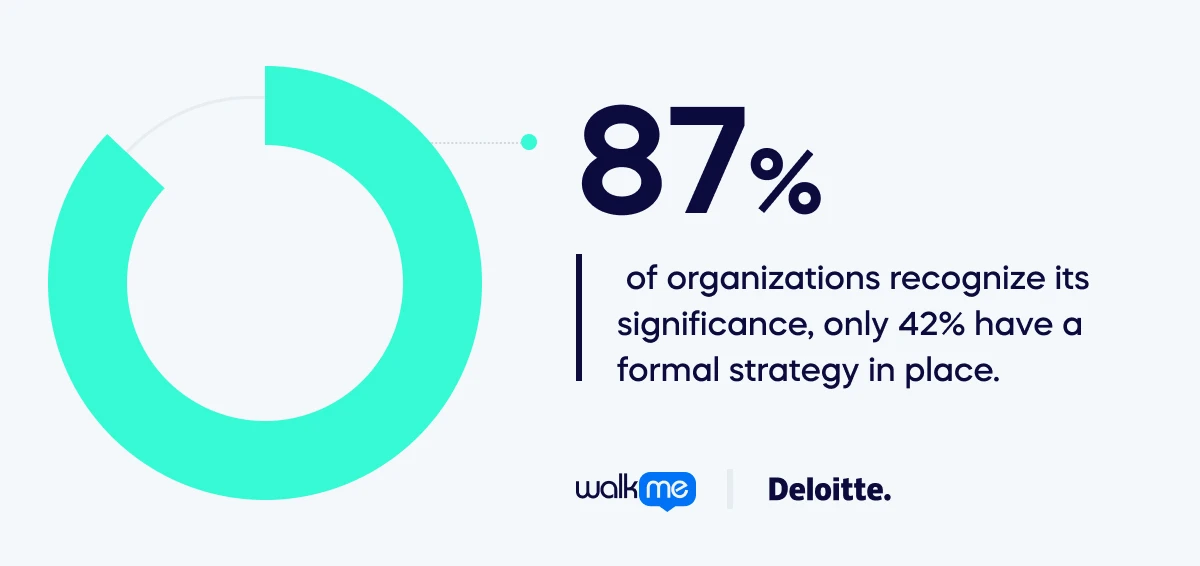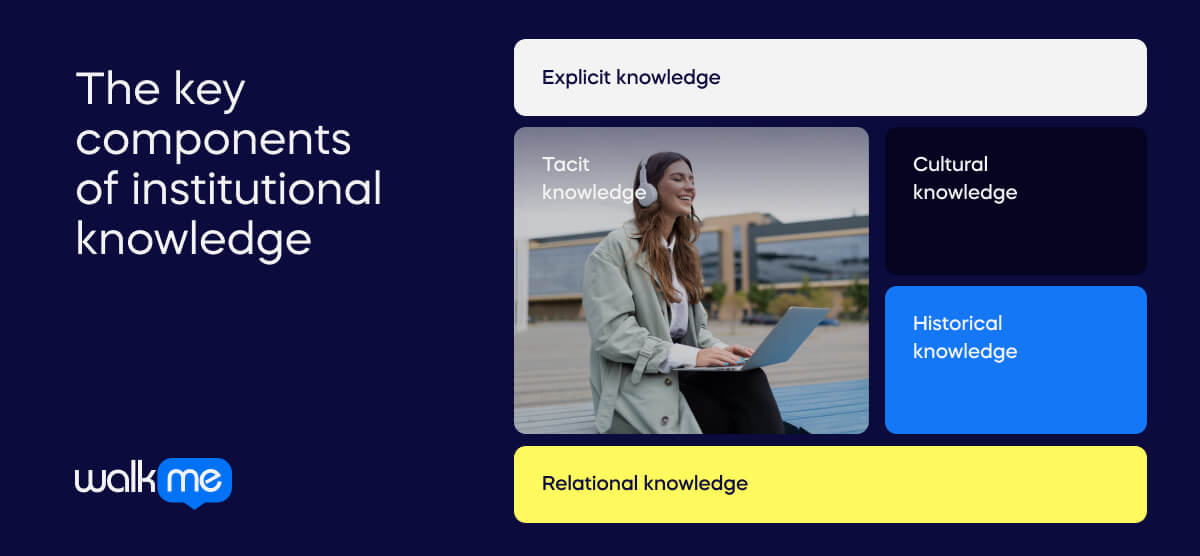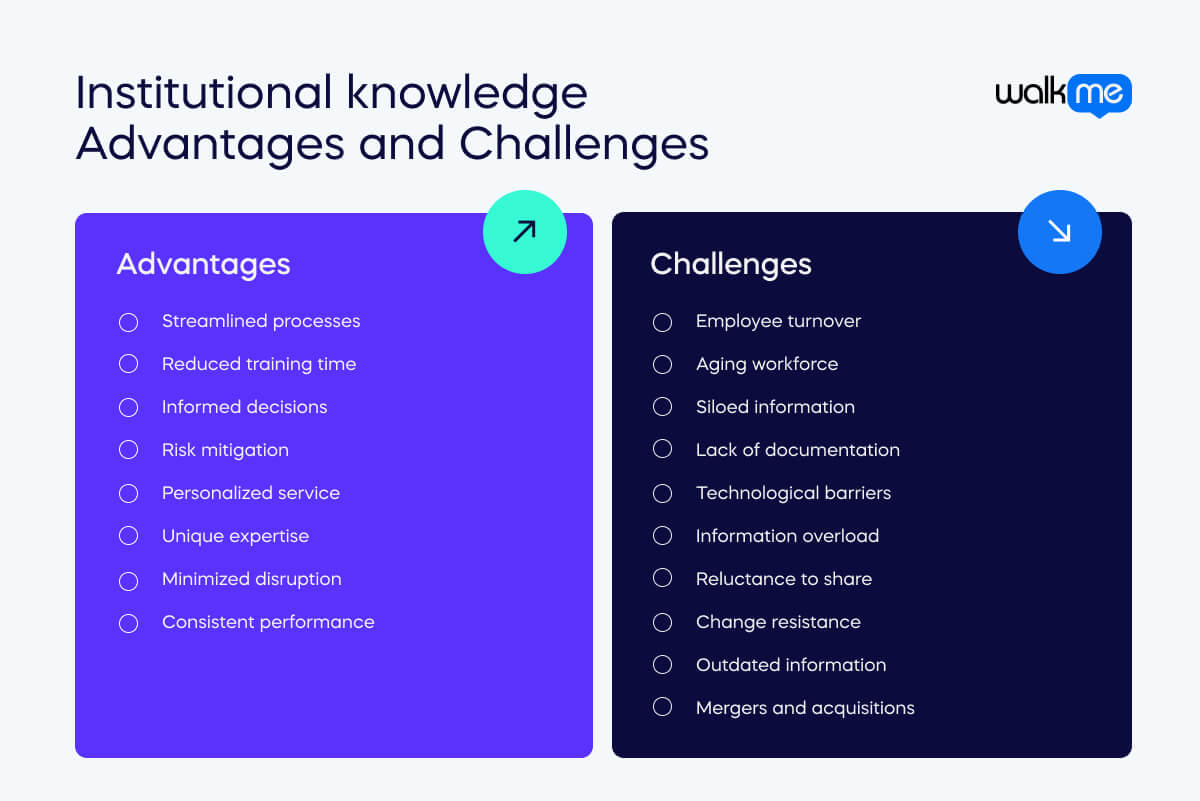What is institutional knowledge?
Institutional knowledge refers to all the understanding, insights, and expertise accumulated in a company over time. Different kinds of knowledge are gathered.For example, there is explicit information, such as documented processes, procedures, and policies.

Table of contents
- What is institutional knowledge?
- What are the key components of institutional knowledge?
- Institutional knowledge vs. knowledge management
- Use cases for institutional knowledge
- What are the advantages of institutional knowledge?
- What are the challenges of institutional knowledge?
- How can DAPs help with institutional knowledge?
- Success stories with institutional knowledge
There is also tacit knowledge, skills, experiences, and unwritten rules employees understand. So why is institutional knowledge valuable? A company needs to run smoothly and continue doing so as employees come and go. Each employee brings their own unique skills and knowledge base to the company. As a result, capturing this information contributes to the database. The downsides of not safekeeping this data can be huge. For example, a study from Panopto reveals that large businesses lose an average of $47 million per year due to inefficient knowledge sharing. Furthermore, a Deloitte study reveals that even though 87% of organizations recognize its significance, only 42% have a formal strategy in place.

Preserving and using institutional knowledge effectively can help companies make better decisions, become more efficient, and cultivate a culture of innovation. What’s more, there are many ways to preserve the information. For example, they can set up mentorship programs, have comprehensive documentation, and set up knowledge management systems. This all helps to capture and disseminate the data. Using such approaches means companies are less likely to experience the risks linked with knowledge loss. They can also ensure new employees can access the insights they need to perform effectively. Overall, institutional knowledge capture contributes to an organization’s long-term success.
What are the key components of institutional knowledge?

An ongoing institutional knowledge capture process would capture many types of knowledge and expertise. Therefore, understanding the key components is essential for those who want to manage and use such a resource.
Explicit knowledge
Documented information such as manuals, databases, policies, and standard operating procedures. It is easily stored and shared, so anyone within the organization can access it. For many, it is a foundational resource invaluable for training new employees and ensuring consistent operations.
Tacit knowledge
Employers’ skills and experiences also need to be captured. These are naturally unwritten or intuitive and can be hard to articulate. However, capturing insights from hands-on experience and informal practice can be invaluable. Typically, this is done via mentoring, collaboration, and social interactions.
Cultural knowledge
The values and beliefs shape the organization’s identity and influence behavior across the company. The culture, traditions, and unwritten rules that guide how things are done are crucial for seamlessly onboarding employees and contributing to maintaining a cohesive work environment.
Historical knowledge
It is also important to capture an organization’s past experiences, including significant events, successes, and failures. Employees will be able to understand the context that drives current practices and decision-making. Furthermore, this knowledge helps guide future strategies so mistakes aren’t repeated.
Relational knowledge
Understanding internal and external relationships is crucial for navigating departments and clients. Documentation or training on stakeholder networks, client connections, and interdepartmental collaborations helps leverage relationships to gain a strategic advantage.
Institutional knowledge vs. knowledge management
Considering institutional knowledge and knowledge management as the same concept can be easy. However, there are some nuances to be aware of.
- Institutional knowledge focuses on the accumulated wisdom, practices, and insights unique to an organization. These are vital for continuity and competitive advantage.
- Knowledge management refers to the processes and tools used to capture, store, and distribute knowledge in the workplace. The aim is to improve collaboration, innovation, and decision-making.
Let’s examine these terms more in-depth. This will help us understand how to strategically leverage internal knowledge assets for sustained growth and adaptability.
| Institutional knowledge | Knowledge management | |
| Definition | The information, experiences, and expertise build up over time. It includes explicit and tacit knowledge, which allows for stability and continuity. | The process and strategy behind identifying, capturing, storing, and sharing knowledge. It aims to make learning accessible so it can be effectively used for efficiency, innovation, and decision-making. |
| Focus | Preserving insights, practices, and expertise that apply to a specific company. They can then be leveraged to contribute to operations and competitive advantage. | Managing the entire knowledge lifecycle in a workplace, spanning creation and capture to sharing and applying insights. The goal is to improve performance and foster a learning culture. |
| Techniques | Mentorship programs Documenting best practices Storytelling sessions | Document management systems Knowledge sharing platforms Collaborative tools |
| Goals | To ensure that knowledge is retained, shared, and applied to support continuous improvement, innovation, and decision-making. | To make relevant knowledge easily accessible so that expertise can be leveraged for agility and competitive advantage. |
| Examples of use | Preserving unique manufacturing processes in a factory Retaining customer insights gathered over years of client interactions Documenting lessons learned from past projects to inform future initiatives | Implementing a centralized knowledge base for technical support teams Creating communities of practice for sharing expertise among employees Using analytics to identify and prioritize knowledge gaps within the organization |
Use cases for institutional knowledge
Institutional knowledge is crucial in various business scenarios. For example, retaining detailed customer histories, optimizing product development processes, or guiding strategic expansions. It can be challenging to grasp how institutional knowledge manifests in practice. So, here are three examples to illustrate its impact in more detail.
Customer relationship management
- A software company has been in business for over a decade, developing custom solutions for various clients.
- Over the years, the company has developed a deep understanding of its clients’ specific preferences and pain points. This information is stored in CRM systems and passed to new account managers.
- Work is put into maintaining detailed records of past interactions, successful project methodologies, and specific technical solutions that worked for each client. As a result, the company can provide personalized and efficient service without starting from scratch every time a new project begins.
- Common issues and solutions are documented, allowing customer service teams to quickly resolve problems based on past experiences. This reduces the response time and keeps clients happy.
Product development
- An automobile manufacturer has been producing vehicles for several decades.
- Knowledge from previous vehicle models, including design successes and failures, is used to inform new product designs. This includes understanding which features customers valued the most and which aspects led to recalls or customer complaints.
- The company documents and uses efficient manufacturing techniques and process optimizations developed over the years. Subsequently, it can maintain consistent quality and effectively train new employees.
- Long-term relationships with reliable suppliers are based on institutional knowledge of their performance, pricing, and reliability. This helps ensure a steady supply of high-quality components and provides negotiation leverage.
Strategic decision making
- A retail chain with multiple stores nationwide is planning to expand its operations.
- The company has gathered extensive data on consumer behavior, sales trends, and regional preferences. This knowledge helps it identify the best locations for new stores and tailor product offerings to local tastes.
- Historical data on competitors’ strategies, market entries, and exits provide insights into what might work or fail in the current market landscape.
- Lessons learned from previous expansions guide the decision-making process. For example, logistical challenges, marketing strategies that worked, and pitfalls to avoid. This institutional knowledge helps formulate a more robust and informed expansion strategy.

What are the advantages of institutional knowledge?
When businesses harness institutional knowledge, they can enjoy several benefits. For example, they can improve efficiency, foster innovation, and make more informed decisions. Companies can also build stronger customer relationships and gain a competitive edge by using collective experience and insights gathered over time. Let’s take a closer look at the various benefits of institutional knowledge.
Streamlined processes
Employees can work more effectively with access to optimal processes and best practices.
Reduced training time
New employees can quickly get up to speed by accessing documented knowledge and learning from experienced colleagues.
Informed decisions
Leaders can make better, evidence-based decisions by accessing historical data and past experiences.
Risk mitigation
Understanding previous mistakes and successes allows organizations to handle potential risks.
Personalized service
Companies can use detailed records of past interactions with customers and their preferences to provide personalized and consistent service.
Unique expertise
When organizations use a unique expertise database, this accumulated information is difficult for competitors to replicate.
Minimized disruption
Institutional knowledge helps maintain continuity when key employees leave, reducing the impact of turnover.
Consistent performance
A well-documented knowledge base ensures that operations continue smoothly and consistently over time.
What are the challenges of institutional knowledge?
Institutional knowledge is invaluable for informed decision-making and operational efficiency. However, there are also some hurdles to be aware of. For example, knowledge retention and sharing across teams must be managed effectively. Furthermore, adjusting to technological advancements and cultural barriers can be challenging. However, it is vital to navigate these issues to harness the full potential of accumulated expertise. Let’s look at these challenges in detail to understand how organizations can effectively address them.
Employee turnover
High turnover rates can lead to the loss of critical knowledge when experienced employees leave the organization.
Aging workforce
Senior employees may not adequately transfer their expertise and historical knowledge to newer staff as they retire.
Siloed information
Knowledge often gets trapped within specific departments or teams, making it difficult for others to access and utilize it.
Lack of documentation
Informal or undocumented knowledge can be hard to capture and share, leading to gaps in the knowledge base.
Technological barriers
If knowledge management systems are inadequate or outdated, this can prevent institutional knowledge from being effectively stored, retrieved, and shared.
Information overload
An overwhelming amount of data and information can make identifying and extracting relevant knowledge challenging.
Reluctance to share
Employees may be unwilling to share their knowledge due to fears of job security, lack of incentives, or a competitive work environment.
Change resistance
If employees resist new knowledge-sharing practices or technologies, institutional knowledge cannot be effectively managed.
Outdated information
Institutional knowledge can become outdated if it is not regularly updated to reflect current practices, technologies, and market conditions.
Mergers and acquisitions
Integrating institutional knowledge from different organizations during mergers and acquisitions can be complex and require careful management.
How can DAPs help with institutional knowledge?
Ensuring the process behind gathering institutional knowledge is consistent can be tough, as can onboarding new employees with a system that introduces them to the database. Fortunately, digital adoption platforms (DAPs) can help preserve and share institutional knowledge within organizations. What’s more, the tools available with these platforms ensure that knowledge remains accessible and relevant, contributing to long-term success and adaptability. Let’s explore the features DAPs can offer companies needing assistance with their institutional knowledge practices.
Onboarding and training
DAPs provide interactive guidance and tutorials for new employees. These help them quickly learn about the organization’s processes, tools, and best practices, making the onboarding process more efficient. Furthermore, new hires will understand institutional knowledge early in the process.
Standardization of processes
DAPs can document and standardize workflows and procedures across the organization. By providing step-by-step guidance, they ensure that employees follow consistent processes. This helps to maintain institutional knowledge in a structured manner.
Knowledge retention
Many organizations face the challenge of knowledge loss when experienced employees leave. DAPs can capture and document their expertise, making it accessible to others. This preserves critical knowledge and prevents disruption to operations when key individuals depart.
Continuous learning
Institutional knowledge evolves over time, and DAPs can support ongoing learning and updates. They can deliver real-time updates, best practices, and new procedures to employees, ensuring they stay informed and skilled.
Improving efficiency
DAPs improve overall operational efficiency by streamlining processes and reducing the learning curve for new tools or systems. Employees spend less time searching for information or troubleshooting issues, increasing productivity.
Analytics and feedback
DAPs often include analytics that track user interactions and feedback. This data can reveal areas where employees struggle or need additional support, allowing organizations to refine their training and knowledge management strategies.
Remote work enablement
With the rise of remote work, DAPs provide a centralized platform where employees can access knowledge regardless of location. This supports collaboration and ensures all team members access the same information.
Success stories with institutional knowledge
Companies across the globe can store and share their institutional knowledge with ease thanks to WalkMe’s digital adoption platform. Here’s an example.
WalkMe x LinkedIn
LinkedIn used WalkMe’s platform by integrating it into its HCM provider. They shared institutional knowledge by building custom Walk-Thrus and SmartTips, which were displayed at the exact moments employees needed them. They did not need to leave the application or receive training from the HR IT team. As a result, they could draw on the accumulated knowledge base to navigate the tool with ease. Now, over 9,000 employees have interacted with WalkMe content. 50 SmartTips have been accessed by over 8,000 workers, and 36 process-focused Walk-Thrus have been played 1,500 times.